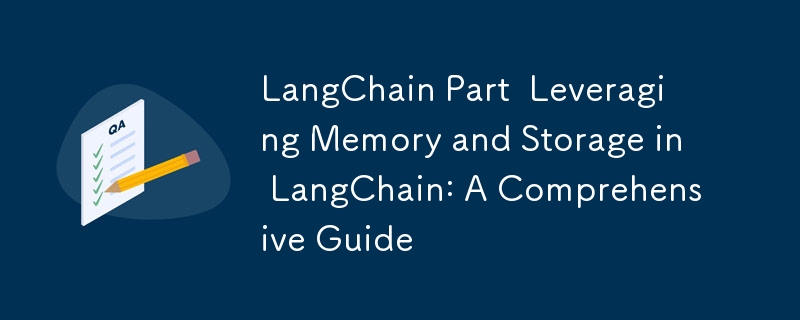LangChain部分利用LangChain中的記憶體和儲存:綜合指南

LangChain 第 4 部分 - 在 LangChain 中利用内存和存储:综合指南
代码可以在这里找到:GitHub - jamesbmour/blog_tutorials:
在对话式人工智能和语言模型不断发展的世界中,维护上下文和有效管理信息流是构建智能应用程序的关键组成部分。 LangChain 是一个强大的框架,专为处理大型语言模型 (LLM) 而设计,为内存管理和数据持久性提供了强大的工具,从而能够创建上下文感知系统。
在本指南中,我们将深入探讨利用 LangChain 中的内存和存储来构建更智能、响应速度更快的应用程序的细微差别。
1. 在 LangChain 中使用内存
LangChain中的内存管理允许应用程序保留上下文,使交互更加连贯和上下文相关。让我们探索不同的内存类型及其用例。
1.1.记忆的类型
LangChain提供了多种内存类型来应对不同的场景。在这里,我们将重点关注两种关键类型:
ConversationBufferMemory
这种记忆类型非常适合短期上下文保留、捕捉和回忆对话中最近的互动。
from langchain.memory import ConversationBufferMemory
memory = ConversationBufferMemory()
memory.save_context({"input": "Hi, I'm Alice"}, {"output": "Hello Alice, how can I help you today?"})
memory.save_context({"input": "What's the weather like?"}, {"output": "I'm sorry, I don't have real-time weather information. Is there anything else I can help you with?"})
print(memory.load_memory_variables({}))
对话摘要内存
对于较长的对话,ConversationSummaryMemory 是一个不错的选择。它总结了要点,保持了上下文,但没有过多的细节。
from langchain.memory import ConversationSummaryMemory
from langchain.llms import Ollama
llm = Ollama(model='phi3',temperature=0)
memory = ConversationSummaryMemory(llm=llm)
memory.save_context({"input": "Hi, I'm Alice"}, {"output": "Hello Alice, how can I help you today?"})
memory.save_context({"input": "I'm looking for a good Italian restaurant"}, {"output": "Great! I'd be happy to help you find a good Italian restaurant. Do you have any specific preferences or requirements, such as location, price range, or specific dishes you're interested in?"})
print(memory.load_memory_variables({}))
1.2.为您的使用案例选择正确的内存类型
选择合适的内存类型取决于几个因素:
- 持续时间和复杂性:短会话受益于 ConversationBufferMemory 的详细上下文保留,而长期交互可能需要通过 ConversationSummaryMemory 进行总结。
- 细节与概述:确定详细的交互历史记录还是高级摘要对您的应用程序更有价值。
- 性能:考虑内存大小和检索速度之间的权衡。
用例:
- ConversationBufferMemory:快速客户支持或常见问题解答式交互的理想选择。
- ConversationSummaryMemory:最适合长期参与,例如项目管理或持续的客户互动。
1.3.将内存集成到链和代理中
内存可以无缝集成到LangChain链和代理中,以增强会话能力。
from langchain.chains import ConversationChain
from langchain.memory import ConversationBufferMemory
# llm = OpenAI(temperature=0)
memory = ConversationBufferMemory()
conversation = ConversationChain(
llm=llm,
memory=memory,
verbose=True
)
conversation.predict(input="Hi, I'm Alice")
conversation.predict(input="What's my name?")
此示例说明了如何使用 ConversationBufferMemory 记住以前的交互,从而实现更自然的对话。
2. 保存和检索数据
持久存储可确保跨会话维护对话历史记录和上下文,从而实现交互的连续性。
2.1.存储对话历史记录和状态
对于基本持久性,您可以将基于文件的存储与 JSON 结合使用:
import json
class PersistentMemory:
def __init__(self, file_path):
self.file_path = file_path
self.load_memory()
def load_memory(self):
try:
with open(self.file_path, 'r') as f:
self.chat_memory = json.load(f)
except FileNotFoundError:
self.chat_memory = {'messages': []}
def save_memory(self):
with open(self.file_path, 'w') as f:
json.dump({'messages': self.chat_memory['messages']}, f)
# Usage
memory = PersistentMemory(file_path='conversation_history.json')
print(memory.chat_memory)
此方法允许您以简单、人类可读的格式保存对话历史记录。
2.2.与数据库和存储系统集成
为了实现更可扩展和更高效的存储,建议与 SQLite 等数据库集成:
import sqlite3
class SQLiteMemory:
def __init__(self, db_path):
self.db_path = db_path
self.conn = sqlite3.connect(db_path)
self.create_table()
def create_table(self):
cursor = self.conn.cursor()
cursor.execute('''
CREATE TABLE IF NOT EXISTS conversations
(id INTEGER PRIMARY KEY, input TEXT, output TEXT)
''')
self.conn.commit()
def save_context(self, inputs, outputs):
cursor = self.conn.cursor()
cursor.execute('INSERT INTO conversations (input, output) VALUES (?, ?)',
(inputs['input'], outputs['output']))
self.conn.commit()
def load_memory_variables(self, inputs):
cursor = self.conn.cursor()
cursor.execute('SELECT input, output FROM conversations ORDER BY id DESC LIMIT 10')
rows = cursor.fetchall()
history = "\\n".join([f"Human: {row[0]}\\nAI: {row[1]}" for row in reversed(rows)])
return {"history": history }
# Usage
memory = SQLiteMemory('conversation_history.db')
print(memory.load_memory_variables({}))
3 优化内存使用和性能
为了确保您的应用程序保持响应,请考虑以下优化策略:
- 高效数据结构:使用双端队列等结构来管理固定大小的缓冲区。
- 缓存策略:通过对经常访问的数据实施缓存来减少数据库查询。
- 数据修剪:定期修剪或汇总旧数据以保持可管理的内存大小。
这是具有基本缓存的内存类的示例:
import time
class CachedSQLiteMemory(SQLiteMemory):
def __init__(self, db_path, cache_ttl=60):
super().__init__(db_path)
self.cache = None
self.cache_time = 0
self.cache_ttl = cache_ttl
def load_memory_variables(self, inputs):
current_time = time.time()
if self.cache is None or (current_time - self.cache_time) > self.cache_ttl:
var = self.cache
self.cache = super().load_memory_variables(inputs)
self.cache_time = current_time
return self.cache
memory = CachedSQLiteMemory('conversation_history.db', cache_ttl=30)
此实现会缓存指定时间的数据库查询结果,减少数据库的负载并提高频繁访问内存数据的应用程序的性能。
结论
有效的内存管理是构建智能、上下文感知的对话式人工智能应用程序的基石。 LangChain提供了灵活而强大的内存管理框架,允许开发人员根据特定用例定制内存类型,实现持久存储解决方案,并优化大规模应用程序的性能。
通过选择正确的内存类型、集成持久存储并利用自定义内存类别和缓存策略等先进技术,您可以构建复杂的 AI 系统,即使在规模和复杂性方面也能维护上下文、改善用户体验并高效运行互动增加。
有了这些可用的工具和技术,您就可以充分利用 LangChain 的全部潜力来创建响应式、智能和情境感知的人工智能应用程序。无论您是开发客户支持机器人、虚拟助理还是复杂的对话系统,掌握 LangChain 中的内存和存储都将是您成功的关键因素。
如果您想支持我的写作或给我买啤酒:
https://buymeacoffee.com/bmours
-
 如何在 PHP 中使用數組函數向左旋轉數組元素?在PHP 中向左旋轉數組元素在PHP 中旋轉數組,將第一個元素移動到最後一個元素並重新索引數組,可以使用PHP 的array_push() 和array_shift() 函數組合來實現。 PHP 函數:PHP 沒有專門用於旋轉的內建函數數組。但是,以下程式碼片段示範如何模擬所需的旋轉行為:$numb...程式設計 發佈於2024-11-06
如何在 PHP 中使用數組函數向左旋轉數組元素?在PHP 中向左旋轉數組元素在PHP 中旋轉數組,將第一個元素移動到最後一個元素並重新索引數組,可以使用PHP 的array_push() 和array_shift() 函數組合來實現。 PHP 函數:PHP 沒有專門用於旋轉的內建函數數組。但是,以下程式碼片段示範如何模擬所需的旋轉行為:$numb...程式設計 發佈於2024-11-06 -
 如何解決Java存取檔案時出現「系統找不到指定的路徑」錯誤?解決Java 中遇到「系統找不到指定的路徑」時的檔案路徑問題在Java 專案中,嘗試存取文字時遇到錯誤來自指定相對路徑的檔案。此錯誤是由於 java.io.File 類別無法定位指定路徑而產生的。 要解決此問題,建議從類別路徑中檢索文件,而不是依賴文件系統。透過這樣做,您可以消除相對路徑的需要,並確...程式設計 發佈於2024-11-06
如何解決Java存取檔案時出現「系統找不到指定的路徑」錯誤?解決Java 中遇到「系統找不到指定的路徑」時的檔案路徑問題在Java 專案中,嘗試存取文字時遇到錯誤來自指定相對路徑的檔案。此錯誤是由於 java.io.File 類別無法定位指定路徑而產生的。 要解決此問題,建議從類別路徑中檢索文件,而不是依賴文件系統。透過這樣做,您可以消除相對路徑的需要,並確...程式設計 發佈於2024-11-06 -
 Laravel 中的 defer() 函數如何運作?Taylor Otwell 最近宣布了 Laravel 中的新函數 defer()。這只是對 defer() 函數如何運作以及使用它可能遇到的問題進行非常基本的概述。 找出問題 還記得您曾經需要從 API 獲取某些內容,然後在幕後執行一些用戶不關心但仍在等待的操作的路由嗎?是的,我們都至少經歷過一...程式設計 發佈於2024-11-06
Laravel 中的 defer() 函數如何運作?Taylor Otwell 最近宣布了 Laravel 中的新函數 defer()。這只是對 defer() 函數如何運作以及使用它可能遇到的問題進行非常基本的概述。 找出問題 還記得您曾經需要從 API 獲取某些內容,然後在幕後執行一些用戶不關心但仍在等待的操作的路由嗎?是的,我們都至少經歷過一...程式設計 發佈於2024-11-06 -
 在 Python Notebook 中探索使用 PySpark、Pandas、DuckDB、Polars 和 DataFusion 的資料操作Apache Iceberg Crash Course: What is a Data Lakehouse and a Table Format? Free Copy of Apache Iceberg the Definitive Guide Free Apache Iceberg Crash ...程式設計 發佈於2024-11-06
在 Python Notebook 中探索使用 PySpark、Pandas、DuckDB、Polars 和 DataFusion 的資料操作Apache Iceberg Crash Course: What is a Data Lakehouse and a Table Format? Free Copy of Apache Iceberg the Definitive Guide Free Apache Iceberg Crash ...程式設計 發佈於2024-11-06 -
 Vue + Tailwind 和動態類我最近在做的一個專案使用了Vite、Vue和Tailwind。 使用自訂顏色一段時間後,我遇到了一些困惑。 在模板中添加和使用自訂顏色不是問題 - 使用 Tailwind 文件使該過程非常清晰 // tailwind.config.js module.exports = { theme:...程式設計 發佈於2024-11-06
Vue + Tailwind 和動態類我最近在做的一個專案使用了Vite、Vue和Tailwind。 使用自訂顏色一段時間後,我遇到了一些困惑。 在模板中添加和使用自訂顏色不是問題 - 使用 Tailwind 文件使該過程非常清晰 // tailwind.config.js module.exports = { theme:...程式設計 發佈於2024-11-06 -
 端對端(E 測試:綜合指南端到端测试简介 端到端(E2E)测试是软件开发生命周期的重要组成部分,确保整个应用程序流程从开始到结束都按预期运行。与专注于单个组件或几个模块之间交互的单元或集成测试不同,端到端测试从用户的角度验证整个系统。这种方法有助于识别应用程序不同部分交互时可能出现的任何问题,确保无缝且无错误的用户体验。 ...程式設計 發佈於2024-11-06
端對端(E 測試:綜合指南端到端测试简介 端到端(E2E)测试是软件开发生命周期的重要组成部分,确保整个应用程序流程从开始到结束都按预期运行。与专注于单个组件或几个模块之间交互的单元或集成测试不同,端到端测试从用户的角度验证整个系统。这种方法有助于识别应用程序不同部分交互时可能出现的任何问题,确保无缝且无错误的用户体验。 ...程式設計 發佈於2024-11-06 -
 可以在 Go 結構標籤中使用變數嗎?在Go 結構體標籤中嵌入變數Go 的結構體標籤通常用於註釋和元數據,通常涉及簡單的字符串文字。但是,使用者可能會遇到在這些標籤中需要動態或計算值的情況。 考慮以下結構,其中帶有為 JSON 封送註解的「類型」欄位:type Shape struct { Type string `json:&...程式設計 發佈於2024-11-06
可以在 Go 結構標籤中使用變數嗎?在Go 結構體標籤中嵌入變數Go 的結構體標籤通常用於註釋和元數據,通常涉及簡單的字符串文字。但是,使用者可能會遇到在這些標籤中需要動態或計算值的情況。 考慮以下結構,其中帶有為 JSON 封送註解的「類型」欄位:type Shape struct { Type string `json:&...程式設計 發佈於2024-11-06 -
 如何增強 Visual Studio 的建置詳細程度以實現深入洞察?熟悉 Visual Studio 的建造詳細程度需要全面了解 Visual Studio 建置過程背後的複雜細節?別再猶豫了! 雖然使用 vcbuild 不會產生所需的詳細輸出,但 Visual Studio 的設定中隱藏著一個解決方案。採取以下簡單步驟即可解鎖大量資訊:導覽至 Visual Stu...程式設計 發佈於2024-11-06
如何增強 Visual Studio 的建置詳細程度以實現深入洞察?熟悉 Visual Studio 的建造詳細程度需要全面了解 Visual Studio 建置過程背後的複雜細節?別再猶豫了! 雖然使用 vcbuild 不會產生所需的詳細輸出,但 Visual Studio 的設定中隱藏著一個解決方案。採取以下簡單步驟即可解鎖大量資訊:導覽至 Visual Stu...程式設計 發佈於2024-11-06 -
 開發者日記# 誰寫的?有個想法困擾著我。也許,我們無法識別它,但日復一日,我們周圍越來越多的人工智慧生成的內容。 LinkedIn 或其他平台上的有趣圖片、影片或貼文。我對帖子的媒體內容沒有疑問(很容易識別它何時生成、從庫存中獲取或創建),但我對帖子的內容表示懷疑。幾乎每次我讀一篇文章時,我都會想這是誰寫的?是作者分享了...程式設計 發佈於2024-11-06
開發者日記# 誰寫的?有個想法困擾著我。也許,我們無法識別它,但日復一日,我們周圍越來越多的人工智慧生成的內容。 LinkedIn 或其他平台上的有趣圖片、影片或貼文。我對帖子的媒體內容沒有疑問(很容易識別它何時生成、從庫存中獲取或創建),但我對帖子的內容表示懷疑。幾乎每次我讀一篇文章時,我都會想這是誰寫的?是作者分享了...程式設計 發佈於2024-11-06 -
 哪一種方法計算資料庫行數較快:PDO::rowCount 或 COUNT(*)?PDO::rowCount 與COUNT(*) 效能在資料庫查詢中計算行數時,選擇使用PDO:: rowCount 和COUNT(*) 會顯著影響效能。 PDO::rowCountPDO::rowCount 傳回受最後一個 SQL 語句影響的行數。但是,對於 SELECT 語句,某些資料庫可能會傳回...程式設計 發佈於2024-11-06
哪一種方法計算資料庫行數較快:PDO::rowCount 或 COUNT(*)?PDO::rowCount 與COUNT(*) 效能在資料庫查詢中計算行數時,選擇使用PDO:: rowCount 和COUNT(*) 會顯著影響效能。 PDO::rowCountPDO::rowCount 傳回受最後一個 SQL 語句影響的行數。但是,對於 SELECT 語句,某些資料庫可能會傳回...程式設計 發佈於2024-11-06 -
 PART# 使用 HTTP 進行大型資料集的高效能檔案傳輸系統让我们分解提供的HTML、PHP、JavaScript和CSS代码对于分块文件上传仪表板部分。 HTML 代码: 结构概述: Bootstrap for Layout:代码使用 Bootstrap 4.5.2 创建一个包含两个主要部分的响应式布局: 分块上传部分:用于...程式設計 發佈於2024-11-06
PART# 使用 HTTP 進行大型資料集的高效能檔案傳輸系統让我们分解提供的HTML、PHP、JavaScript和CSS代码对于分块文件上传仪表板部分。 HTML 代码: 结构概述: Bootstrap for Layout:代码使用 Bootstrap 4.5.2 创建一个包含两个主要部分的响应式布局: 分块上传部分:用于...程式設計 發佈於2024-11-06 -
 比較:Lithe 與其他 PHP 框架如果您正在為下一個專案探索 PHP 框架,很自然會遇到 Laravel、Symfony 和 Slim 等選項。但是,是什麼讓 Lithe 與這些更強大、更知名的框架區分開來呢?以下是一些突出 Lithe 如何脫穎而出的注意事項。 1. 輕量級與性能 Lithe 的設計重點在於輕量級...程式設計 發佈於2024-11-06
比較:Lithe 與其他 PHP 框架如果您正在為下一個專案探索 PHP 框架,很自然會遇到 Laravel、Symfony 和 Slim 等選項。但是,是什麼讓 Lithe 與這些更強大、更知名的框架區分開來呢?以下是一些突出 Lithe 如何脫穎而出的注意事項。 1. 輕量級與性能 Lithe 的設計重點在於輕量級...程式設計 發佈於2024-11-06 -
 程式設計風格指南:編寫簡潔程式碼的實用指南在过去的五年里,我一直在不断尝试提高我的编码技能,其中之一就是学习和遵循最推荐的编码风格。 本指南旨在帮助您编写一致且优雅的代码,并包含一些提高代码可读性和可维护性的建议。它的灵感来自于社区中最受接受的流行指南,但进行了一些修改以更适合我的喜好。 值得一提的是,我是一名全栈 JavaScript 开...程式設計 發佈於2024-11-06
程式設計風格指南:編寫簡潔程式碼的實用指南在过去的五年里,我一直在不断尝试提高我的编码技能,其中之一就是学习和遵循最推荐的编码风格。 本指南旨在帮助您编写一致且优雅的代码,并包含一些提高代码可读性和可维护性的建议。它的灵感来自于社区中最受接受的流行指南,但进行了一些修改以更适合我的喜好。 值得一提的是,我是一名全栈 JavaScript 开...程式設計 發佈於2024-11-06 -
 檢查類型是否滿足 Go 中的接口在Go中,開發人員經常使用介面來定義預期的行為,使程式碼靈活且健壯。但是如何確保類型真正實現接口,尤其是在大型程式碼庫中? Go 提供了一種簡單有效的方法來在編譯時驗證這一點,防止執行時間錯誤的風險並使您的程式碼更加可靠和可讀。 您可能看過類似的文法 var _ InterfaceName = ...程式設計 發佈於2024-11-06
檢查類型是否滿足 Go 中的接口在Go中,開發人員經常使用介面來定義預期的行為,使程式碼靈活且健壯。但是如何確保類型真正實現接口,尤其是在大型程式碼庫中? Go 提供了一種簡單有效的方法來在編譯時驗證這一點,防止執行時間錯誤的風險並使您的程式碼更加可靠和可讀。 您可能看過類似的文法 var _ InterfaceName = ...程式設計 發佈於2024-11-06 -
 掌握 JavaScript 中的 &#this&# 關鍵字JavaScript 中的 this 關鍵字如果不理解的話可能會非常棘手。這是即使是經驗豐富的開發人員也很難輕鬆掌握的事情之一,但一旦你掌握了,它可以為你節省大量時間。 在本文中,我們將了解它是什麼、它在不同情況下如何運作以及使用它時不應陷入的常見錯誤。 在 JavaScript...程式設計 發佈於2024-11-06
掌握 JavaScript 中的 &#this&# 關鍵字JavaScript 中的 this 關鍵字如果不理解的話可能會非常棘手。這是即使是經驗豐富的開發人員也很難輕鬆掌握的事情之一,但一旦你掌握了,它可以為你節省大量時間。 在本文中,我們將了解它是什麼、它在不同情況下如何運作以及使用它時不應陷入的常見錯誤。 在 JavaScript...程式設計 發佈於2024-11-06
學習中文
- 1 走路用中文怎麼說? 走路中文發音,走路中文學習
- 2 坐飛機用中文怎麼說? 坐飞机中文發音,坐飞机中文學習
- 3 坐火車用中文怎麼說? 坐火车中文發音,坐火车中文學習
- 4 坐車用中文怎麼說? 坐车中文發音,坐车中文學習
- 5 開車用中文怎麼說? 开车中文發音,开车中文學習
- 6 游泳用中文怎麼說? 游泳中文發音,游泳中文學習
- 7 騎自行車用中文怎麼說? 骑自行车中文發音,骑自行车中文學習
- 8 你好用中文怎麼說? 你好中文發音,你好中文學習
- 9 謝謝用中文怎麼說? 谢谢中文發音,谢谢中文學習
- 10 How to say goodbye in Chinese? 再见Chinese pronunciation, 再见Chinese learning

























